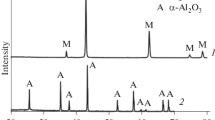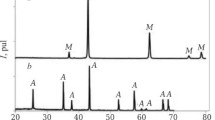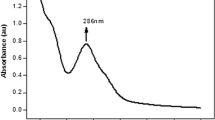The objects of investigation are foam ceramic materials based on aluminum oxide, magnesium oxide, and alumina-magnesia spinel. The results of investigations on the sintering of spinel ceramic using aluminum and magnesium oxides as the initial components are presented. It is shown that the optimal range of the sintering temperatures for obtaining materials with open-cellular pore structure is 1600 – 1700°C. Materials with interconnected porosity up to 85% and strength in compression up to 1.4 MPa were obtained.







Similar content being viewed by others
References
E. N. Kablov, “Innovative developments of the Federal State Unitary Enterprise VIAM SSC RF for the implementation of ‘Strategic directions for the development of materials and technologies for their processing up to 2030,” Aviats. Mater. Tekhnol., No. 1(34), 3 – 33 (2015); https://doi.org/10.18577/2071-9140-2015-0-1-3-33.
E. N. Kablov, “At the crossroads of science, education and industry,” Ekspert, No. 15(941), 49 – 53 (2015).
Z. Taslicukur, C. Balaban, and N. Kuskonmaz, “Production of ceramic foam filters for molten metal filtration using expanded polystyrene,” J. Europ. Ceram. Soc., No. 27, 637 – 640 (2007).
A. I. Kozlov, V. N. Grunsky, A. V. Bespalov, et al., “Method of manufacturing highly porous cellular ceramic products, Pat. RF 2377224, No. 2008114080/03,” Byull. Izobr. Polezn. Modeli, No. 9 (2009); declared April 14, 2009; publ. December 27, 2009.
M. D. Gasparyan, V. N. Grunsky, A. V. Bespalov, et al., “Method of obtaining ceramic highly porous block-cellular materials, Pat. RF 2580959, No. 2015112820/03,” Byull. Izobr. Polezn. Modeli, No. 10 (2016); declared April 8, 2015; publ. April 10, 2016.
Masuda Toshihide and Kido Tomoyuki, Manufacturing Method of a Ceramics Body Having Through Holes, Pat. 4664858 USA No. 765340; declared March 8, 1985; published May 12, 1987.
E. N. Kablov, B. V. Shchetanov, Yu. A. Ivakhnenko, and Yu. A. Balinova, “Promising high-temperature reinforcing fibers for metal and ceramic composite materials,” Tr. VIAM, Elektron. Nauch.-Tekhn. Zh., No. 2, Art. 5 (2013); URL: http://www.viam-works.ru (date of access April 3, 2019)
N. V. Buchilin, E. P. Prager, and Yu. A. Ivakhnenko, “Effect of plasticizing additives on rheological characteristics of slips for the preparation of porous ceramic materials based on aluminum oxide,” Tr. VIAM, Elektron. Nauch.-Tekh. Zh., No. 8, Art. 06 (2016); URL: http://www.viam-works.ru (date of access Jule 3, 2019); https://doi.org/10.18577/2307-6046-2016-0-8-6-6.
M. O. Senina, D. O. Lemeshev, and V. A. Kolesnikov, “Methods of synthesizing alumomagnesium spinel powders for obtaining transparent ceramic (Review),” Steklo Keram., No. 10, 19 – 25 (2017); M. O. Senina, D. O. Lemeshev, and V. A. Kolesnikov, “Methods of synthesizing alumomagnesium spinel powders for obtaining transparent ceramic (Review),” Glass Ceram., 74(9 – 10), 358 – 363 (2017).
V. A. Gorshkov, P. A. Miloserdov, V. I. Yukhvid, et al., “Obtaining magnesium-aluminum spinel by SHS-metallurgy methods,” Neorg. Mater., 53(10), 1070 – 1075 (2017).
Yu. N. Kryuchkov, “Determination of the average capillary radius of porous materials,” Steklo keram., No. 4, 16 – 21 (2018); Yu. N. Kryuchkov, “Determination of the average capillary radius of porous materials,” Glass Ceram., 75(3 – 4), 139 – 144 (2018).
O. A. Slyusar and V. M. Uvarov, “Influence of complex additives on the mobility of ceramic slip,” Steklo Keram., No. 3, 44 – 46 (2017); O. A. Slyusar and V. M. Uvarov, “Influence of complex additives on the mobility of ceramic slip,” Glass Ceram., 74(3 – 4), 110 – 111 (2017).
O. V. Kichkailo and I. A. Levitskii, “Rheological characteristics of slips in the preparation of heat-resistant lithium aluminum silicate ceramics,” Steklo Keram., No. 7, 37 – 44 (2017); O. V. Kichkailo and I. A. Levitskii, “Rheological characteristics of slips in the preparation of heat-resistant lithium aluminum silicate ceramics,” Glass Ceram., No. 7 – 8, 257 – 263 (2017).
A. A. Evteev, “Some aspects of the development of optimal modes of firing ceramic compositions containing eutectic additives,” Tr. VIAM Elektron. Nauch.-Tekh. Zh., No. 2(38), 101 – 106 (2016); URL: http://www.viamworks.ru (date of access July 3, 2019); https://doi.org/10.18577/2307-6046-2016-0-2-12-12.
N. Ye. Shchegoleva, A. S. Chainikova, and L. A. Orlova, “Investigation of the sintering process in the production of glass ceramics based on strontium aluminosilicate glass by the method of semi-dry pressing,” Aviats. Mater. Tekhnol., No. 4(53), 55 – 62 (2018); https://doi.org/10.18577/2071-9140-2018-0-4-55-62.
T. V. Safronova, V. I. Putlyaev, Ya. Yu. Filippov, et al., “Ceramics based on brushite powder synthesized from calcium nitrate and sodium and potassium hydrogen phosphates,” Neorg. Mater., 54(2), 210 – 220 (2018).
D. O. Savinykh, S. A. Khainakov, M. S. Boldin, et al., “Obtaining and thermal expansion of powders and ceramics CA0.75+0.5xZr1.5Fe0.5 (PO4)3–x (SiO4)x with NZP structure,” Neorg. Mater., 54(12), 1338 – 1344 (2018).
N. V. Buchilin, G. Yu. Lyulyukina, and N. M. Varrik, “Influence of the firing regime on the structure and properties of highly porous ceramic materials based on magnesia-alumina spinel,” Novye Ogneupory, No. 1, 37 – 42 (2019).
I. Ya. Guzman (ed.), Chemical Technology of Ceramics [in Russian], Stroimaterialy, Moscow (2003).
S. V. Zhitnyuk, “Oxygen-free ceramic materials for aerospace engineering (review),” Tr. VIAM, Elektron. Nauch.-Tekh. Zh., No. 8(68), 81 – 88 (2018); URL: http://www.viam-works.ru (date of access July 3, 2019); https://doi.org/10.18577/2307-6046-2018-0-8-81-88.
D. S. Kashin, P. Ye. Dergacheva, and P. A. Stekhov, “Heat-resistant coatings applied by the slip method (review),” Tr. VIAM, Elektron. Nauch.-Tekh. Zh., No. 5(65), 64 – 75 (2018); URL: http://www.viam-works.ru (date of access July 3, 2019); https://doi.org/10.18577/2307-6046-2018-0-5-64-75.
A. I. Kovtunov, Yu. Yu. Khokhlov, and S. V. Myamin, “Technology of formation and properties of composite foams,” Aviats. Mater. Tekhnol., No. 3(36), 64 – 68 (2015); https://doi.org/10.18577/2071-9140-2015-0-3-64-68.
Next-Generation Materials and Technologies for Advanced Products of Aviation and Space Technology: Proceedings of the 4th All-Russian Scientific and Technical Conference, Moscow, 26 August 2019 [Electronic resource], FSUE VIAM, VIAM, Moscow (2019).
N. V. Buchilin, G. Yu. Lyulyukina, and N. M. Varrik, “Influence of the firing regime on the structure and properties of highly porous ceramic materials based on mullite,” Tr. VIAM, Elektron. Nauch.-Tekh. Zh., No. 5(53), 32 – 41 (2017); URL: http://www.viam-works.ru (date of access March 7, 2019); https://doi.org/10.18577/2307-6046-2017-0-5-32-41.
Author information
Authors and Affiliations
Corresponding author
Additional information
Translated from Steklo i Keramika, No. 10, pp. 7 – 14, October, 2020.
Rights and permissions
About this article
Cite this article
Buchilin, N.V., Nikitina, V.Y., Lugovoi, A.A. et al. Preparation of Alumina-Magnesia Spinel Based High-Porosity Ceramic Materials. Glass Ceram 77, 372–378 (2021). https://doi.org/10.1007/s10717-021-00310-2
Published:
Issue Date:
DOI: https://doi.org/10.1007/s10717-021-00310-2




